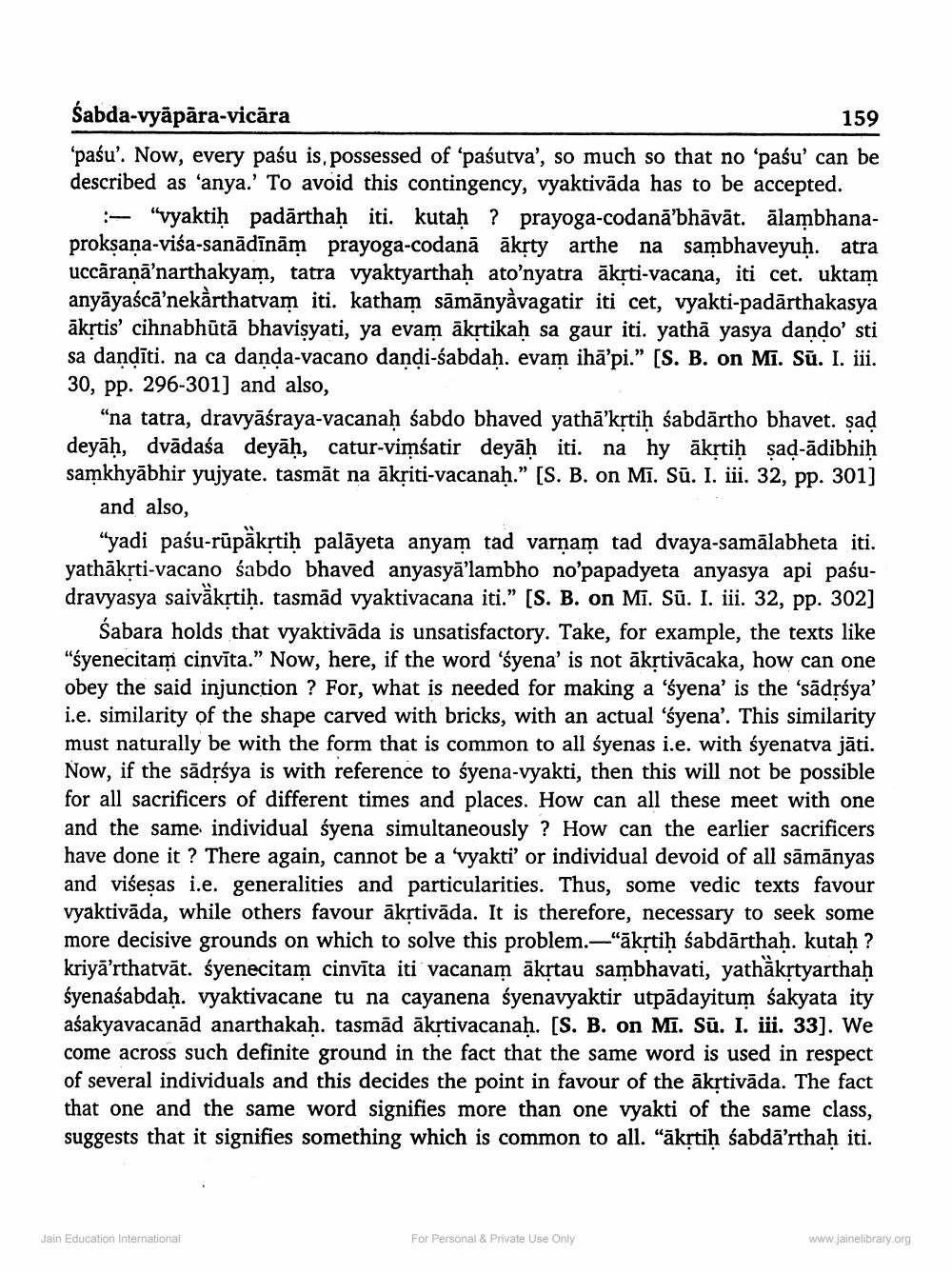________________
Sabda-vyāpāra-vicāra
159
'pasu'. Now, every pasu is possessed of 'paśutva', so much so that no 'pasu' can be described as "anya.' To avoid this contingency, vyaktivāda has to be accepted.
:- "vyaktih padārthah iti. kutah ? prayoga-codanā'bhāvāt. ālambhanaproksana-viša-sanādīnām prayoga-codanā ākrtyarthena sambhaveyuḥ. atra uccāraņā'narthakyam, tatra vyaktyarthaḥ ato'nyatra āksti-vacana, iti cet. uktam anyāyaścā'nekārthatvam iti. katham sāmānyavagatir iti cet, vyakti-padārthakasya akrtis' cihnabhūtā bhavisyati, ya evam ākrtikah sa gaur iti. yathā yasya dando' sti sa dandīti, na ca danda-vacano dandi-sabdah. evam ihā'pi.” IS. B. on Mi. Sū. 30, pp. 296-301) and also,
"na tatra, dravyāśraya-vacanah sabdo bhaved vatha'krtih sabdārtho bhavet. sad deyāḥ, dvādaśa deyāḥ, catur-vimsatir deyāḥ iti. na hyākstiḥ sad-ādibhiḥ samkhyābhir yujyate. tasmāt na ākriti-vacanah." [S. B. on Mi. Sū. I. iii. 32, pp. 301]
and also,
"yadi paśu-rūpākrtiḥ palāyeta anyam tad varņam tad dvaya-samālabheta iti. yathākrti-vacano śabdo bhaved anyasyā'lambho no'papadyeta anyasya api pasudravyasya saiväkṛtiḥ. tasmād vyaktivacana iti." [S. B. on Mī. Sū. I. iii. 32, pp. 302]
Śabara holds that vyaktivāda is unsatisfactory. Take, for example, the texts like "syenecitam cinvīta." Now, here, if the word 'śyena' is not ākstivācaka, how can one obey the said injunction ? For, what is needed for making a 'syena' is the 'sādrśya' i.e. similarity of the shape carved with bricks, with an actual 'śyena'. This similarity must naturally be with the form that is common to all śyenas i.e. with śyenatva jāti. Now, if the sādrśya is with reference to śyena-vyakti, then this will not be possible for all sacrificers of different times and places. How can all these meet with one and the same individual śyena simultaneously ? How can the earlier sacrificers have done it ? There again, cannot be a 'vyakti' or individual devoid of all sāmānyas and viśesas i.e. generalities and particularities. Thus, some vedic texts favour vyaktivāda, while others favour ākrtivāda. It is therefore, necessary to seek some more decisive grounds on which to solve this problem.—“ākrtih sabdārthah. kutah ? kriyā'rthatvāt. śyenecitam cinvīta iti vacanam akrtau sambhavati, yathākrtyarthah śyenaśabdah. vyaktivacane tu na cayanena śyenavyaktir utpādayitum sakyata ity aśakyavacanād anarthakaḥ. tasmād ākstivacanaḥ. [S. B. on Mi. Sū. I. iii. 33). We come across such definite ground in the fact that the same word is used in respect of several individuals and this decides the point in favour of the ākrtivāda. The fact that one and the same word signifies more than one vyakti of the same class, suggests that it signifies something which is common to all. "ākrtih sabdā'rthah iti.
Jain Education International
For Personal & Private Use Only
www.jainelibrary.org




